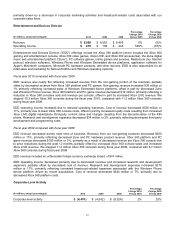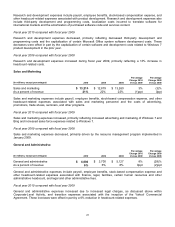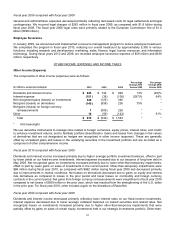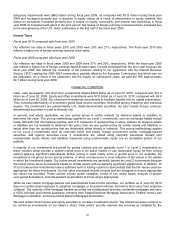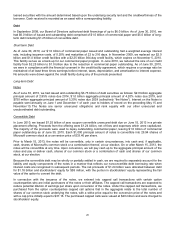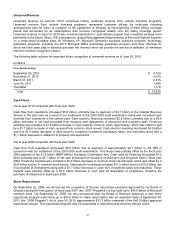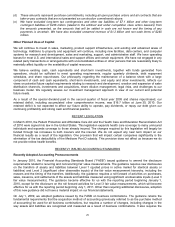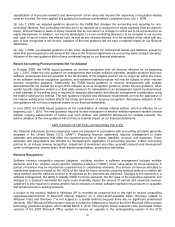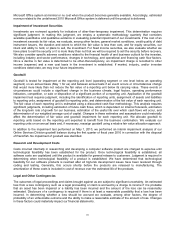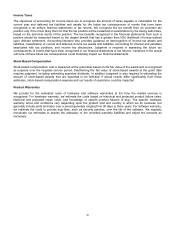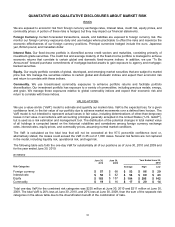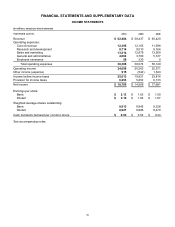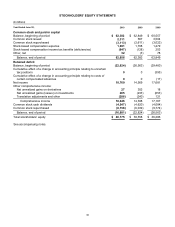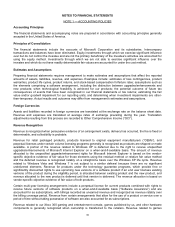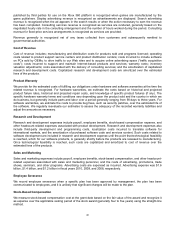Microsoft 2010 Annual Report Download - page 31
Download and view the complete annual report
Please find page 31 of the 2010 Microsoft annual report below. You can navigate through the pages in the report by either clicking on the pages listed below, or by using the keyword search tool below to find specific information within the annual report.
30
capitalization of in-process research and development at fair value and requires the expensing of acquisition-related
costs as incurred. We have applied this guidance to business combinations completed since July 1, 2009.
On July 1, 2009, we adopted guidance issued by the FASB that changes the accounting and reporting for non-
controlling interests. Non-controlling interests are to be reported as a component of equity separate from the parent’s
equity, and purchases or sales of equity interests that do not result in a change in control are to be accounted for as
equity transactions. In addition, net income attributable to a non-controlling interest is to be included in net income
and, upon a loss of control, the interest sold, as well as any interest retained, is to be recorded at fair value with any
gain or loss recognized in net income. Adoption of the new guidance did not have a material impact on our financial
statements.
On July 1, 2009, we adopted guidance on fair value measurement for nonfinancial assets and liabilities, except for
items that are recognized or disclosed at fair value in the financial statements on a recurring basis (at least annually).
Adoption of the new guidance did not have a material impact on our financial statements.
Recent Accounting Pronouncements Not Yet Adopted
In October 2009, the FASB issued guidance on revenue recognition that will become effective for us beginning
July 1, 2010. Under the new guidance on arrangements that include software elements, tangible products that have
software components that are essential to the functionality of the tangible product will no longer be within the scope
of the software revenue recognition guidance, and software-enabled products will now be subject to other relevant
revenue recognition guidance. Additionally, the FASB issued guidance on revenue arrangements with multiple
deliverables that are outside the scope of the software revenue recognition guidance. Under the new guidance, when
vendor specific objective evidence or third party evidence for deliverables in an arrangement cannot be determined,
a best estimate of the selling price is required to separate deliverables and allocate arrangement consideration using
the relative selling price method. The new guidance includes new disclosure requirements on how the application of
the relative selling price method affects the timing and amount of revenue recognition. We believe adoption of this
new guidance will not have a material impact on our financial statements.
In June 2009, the FASB issued guidance on the consolidation of variable interest entities, which is effective for us
beginning July 1, 2010. The new guidance requires revised evaluations of whether entities represent variable interest
entities, ongoing assessments of control over such entities, and additional disclosures for variable interests. We
believe adoption of this new guidance will not have a material impact on our financial statements.
APPLICATION OF CRITICAL ACCOUNTING POLICIES
Our financial statements and accompanying notes are prepared in accordance with accounting principles generally
accepted in the United States (“U.S. GAAP”). Preparing financial statements requires management to make
estimates and assumptions that affect the reported amounts of assets, liabilities, revenue, and expenses. These
estimates and assumptions are affected by management’s application of accounting policies. Critical accounting
policies for us include revenue recognition, impairment of investment securities, goodwill, research and development
costs, contingencies, income taxes, stock-based compensation, and product warranties.
Revenue Recognition
Software revenue recognition requires judgment, including whether a software arrangement includes multiple
elements, and if so, whether vendor-specific objective evidence (“VSOE”) of fair value exists for those elements. A
portion of revenue may be recorded as unearned due to undelivered elements. The amount of revenue allocated to
undelivered elements is based on the VSOE of fair value for those elements using the residual method or relative fair
value method, and the deferred revenue is recognized as the elements are delivered. Changes to the elements in a
software arrangement, the ability to identify VSOE for those elements, the fair value of the respective elements, and
changes to a product’s estimated life cycle could materially impact the amount of earned and unearned revenue.
Judgment is also required to assess whether future releases of certain software represent new products or upgrades
and enhancements to existing products.
A portion of the revenue related to Windows XP is recorded as unearned due to the right to receive unspecified
upgrades/enhancements of Microsoft Internet Explorer on a when-and-if-available basis. Revenue related to
Windows Vista and Windows 7 is not subject to a similar deferral because there are no significant undelivered
elements. 2007 Microsoft Office system revenue is subject to deferral as a result of the 2010 Microsoft Office system
technology guarantee program, which started March 5, 2010. This program allows customers who purchased certain
versions of the 2007 Microsoft Office system to receive an upgrade to the corresponding version of the 2010



